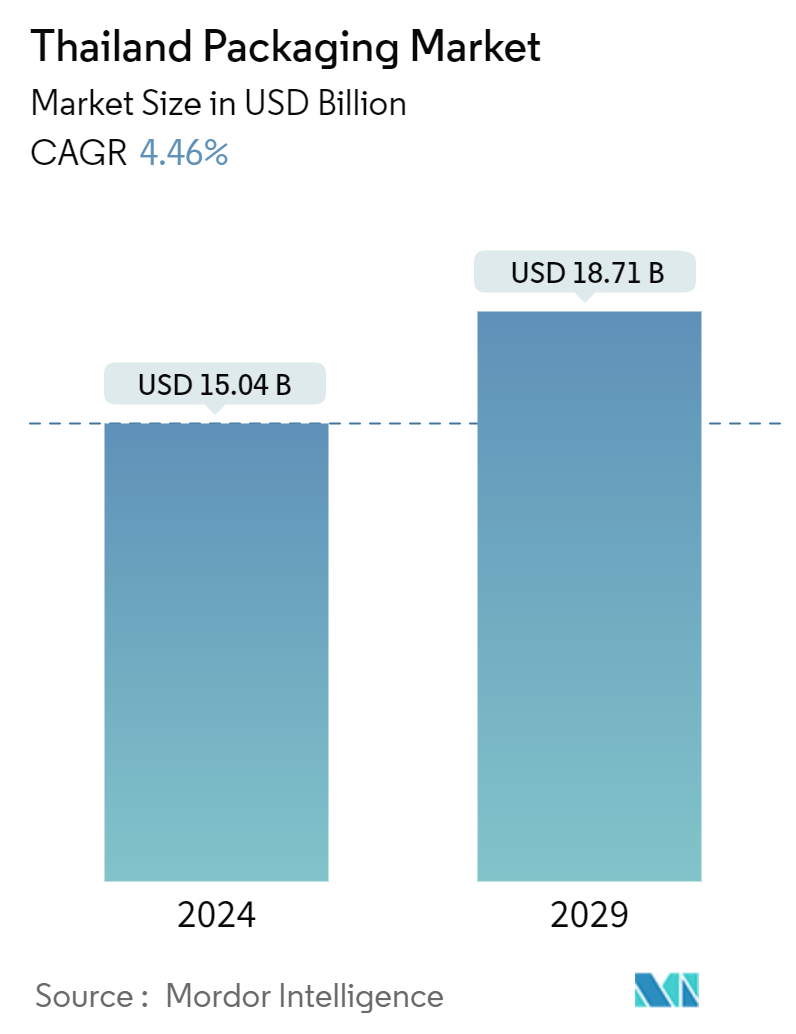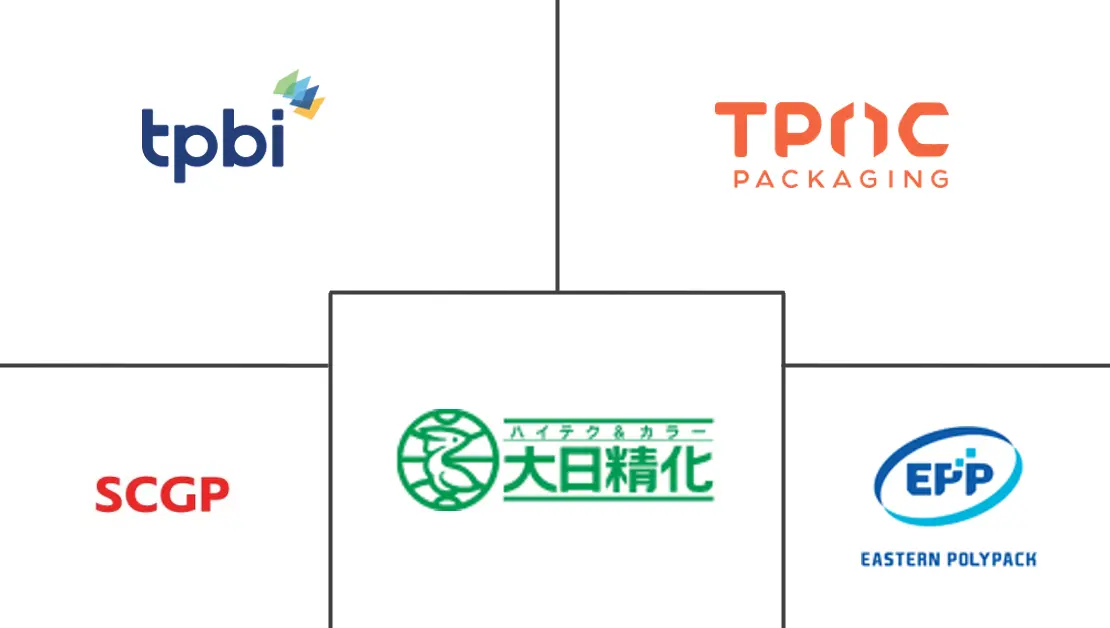Market Size of Thailand Packaging Industry

| Study Period | 2019 - 2029 |
| Base Year For Estimation | 2023 |
| Market Size (2024) | USD 15.04 Billion |
| Market Size (2029) | USD 18.71 Billion |
| CAGR (2024 - 2029) | 4.46 % |
| Market Concentration | Low |
Major Players
*Disclaimer: Major Players sorted in no particular order |
Thailand Packaging Market Analysis
The Thailand Packaging Market size is estimated at USD 15.04 billion in 2024, and is expected to reach USD 18.71 billion by 2029, growing at a CAGR of 4.46% during the forecast period (2024-2029).
Thailand's economic expansion has led to a steady rise in both the production and consumption of packaging goods throughout time. The Thailand packaging industry is expanding and making a substantial economic contribution. This is a result of the growing need for packaging supplies that are appropriate for anything and can be used to pack anything.
- The Thai packaging industry has consistently grown over the past 10 years due to changes in substrate preferences, the opening of new markets, and shifting ownership dynamics. Sustainability and environmental concerns may still be highlighted, especially in developed nations, and the industry is seeing a variety of technologies that cater to paper and plastic packaging.
- Moreover, consumption of non-recyclable plastic packaging is on the rise. As a result, there could be less need for secondary packaging and increasing demand for environmentally friendly packaging materials, including paper and board, recovered PET (rPET), and bioplastic.
- Flexible packaging may eventually supplant conventional packaging. For a variety of food goods, high-barrier films and stand-up retort pouches may compete with rigid pack forms like metal cans and glass jars. Consumers' need for convenience in food may be met via microwaveable ready meals, more portable packaging, packaging for consumption on the go, and convenience features like easy-open and reseal components.
- Furthermore, the complexity and level of competition in the retail industry are other important aspects that influence the market. Modern retail trade shops, such as supermarkets and convenience stores, which may stock a wider variety of frozen food goods, are more widely used. Flexible packaging for frozen foods, such as shrink films, flexible bags, lidding films, high barrier thermoforming films, and skin films, are being adopted at previously unheard-of rates in a number of growing countries.
- While regulations emerging on plastic usage could restrain the growth of flexible packaging in Thailand, for instance, in January 2023, the Thai Industrial Standards Institute (TISI) released the Draft Ministerial Regulation on Plastic Bags for Food (TIS 1027-25xx (20xx)). This outlines safety requirements for substances in the material, as well as specifications for marking, labeling, and testing criteria. It specifically applies to plastic bags made from virgin resin as single-layer plastic films for food packaging. It's important to note that this standard does not apply to custom-printed plastic bags with ink.
Thailand Packaging Industry Segmentation
Packaging is the process of enclosing or containing a product in bottles, plastic bags, wrappers, paper cartons, boxes, etc. It serves the purpose of displaying useful information about the product, including its contents, weight, size, price, constituents, and necessary instructions for usage and storage. Packaging helps reduce the risk of wastage, spoilage, leakage, and evaporation during transportation and storage.
The Thai packaging market is segmented by packaging material (plastic, paper, paperboard, glass, and metal), packaging type (flexible packaging (pouches, bags, and packaging films), rigid packaging (bottles and jars, corrugated boxes and folding cartons, metal cans, drums, and bulk containers)), and end user (food, beverage, beauty and personal care, industrial, pharmaceutical, and other end users). The market sizes and forecasts are provided in terms of value (USD) for all the above segments.
| By Packaging Material | |
| Plastic | |
| Paper and Paperboard | |
| Glass | |
| Metal |
| By Packaging Type | |||||||
| |||||||
|
| By End User | |
| Food | |
| Beverage | |
| Beauty and Personal Care | |
| Industrial | |
| Pharmaceutical | |
| Other End Users |
Thailand Packaging Market Size Summary
The packaging industry in Thailand is experiencing robust growth, driven by the country's economic expansion and increasing demand for diverse packaging solutions. This sector is characterized by its adaptability to changing consumer preferences and market dynamics, including the shift towards sustainable and environmentally friendly materials. The industry is witnessing a rise in the use of flexible packaging, which offers convenience and efficiency, particularly in the food sector. Innovations in packaging technologies, such as high-barrier films and stand-up retort pouches, are gaining traction as they cater to the evolving needs of consumers for convenience and portability. The market is also influenced by the growing complexity of the retail landscape, with modern trade channels like supermarkets and convenience stores expanding their offerings, including frozen food items, which require advanced packaging solutions.
The Thai packaging market is highly fragmented, with several key players actively pursuing growth through technological advancements and strategic partnerships. Companies like Dainichiseika Color & Chemicals Mfg. Co. Ltd, Fagerdala Singapore Pte Ltd, and TPBI Public Company Limited are prominent in the market, focusing on expanding their reach and enhancing their product offerings. Recent collaborations, such as the partnership between Kao Industrial (Thailand) Co. Ltd, SCG Chemicals Co. Ltd, and Dow Thailand Group, aim to develop sustainable and recyclable packaging solutions, reflecting the industry's commitment to reducing its carbon footprint. The market's growth is further supported by the increasing demand for packaging in the food and beverage sector, which is a significant contributor to Thailand's GDP, and the rising consumption of packaged goods driven by changing lifestyles and economic development.
Thailand Packaging Market Size - Table of Contents
-
1. MARKET DYNAMICS
-
1.1 Market Overview
-
1.2 Industry Value Chain Analysis
-
1.3 Industry Attractiveness - Porter's Five Forces Analysis
-
1.3.1 Bargaining Power of Suppliers
-
1.3.2 Bargaining Power of Consumers
-
1.3.3 Threat of New Entrants
-
1.3.4 Threat of Substitute Products
-
1.3.5 Intensity of Competitive Rivalry
-
-
1.4 Assessment of the Impact of the COVID-19 Pandemic on the Industry
-
-
2. MARKET SEGMENTATION
-
2.1 By Packaging Material
-
2.1.1 Plastic
-
2.1.2 Paper and Paperboard
-
2.1.3 Glass
-
2.1.4 Metal
-
-
2.2 By Packaging Type
-
2.2.1 Flexible Packaging
-
2.2.1.1 Pouches
-
2.2.1.2 Bags
-
2.2.1.3 Packaging Films
-
2.2.1.4 Other Product Types
-
-
2.2.2 Rigid Packaging
-
2.2.2.1 Bottles and Jars
-
2.2.2.2 Corrugated Boxes and Folding Cartons
-
2.2.2.3 Metal Cans
-
2.2.2.4 Drums
-
2.2.2.5 Bulk Containers
-
-
-
2.3 By End User
-
2.3.1 Food
-
2.3.2 Beverage
-
2.3.3 Beauty and Personal Care
-
2.3.4 Industrial
-
2.3.5 Pharmaceutical
-
2.3.6 Other End Users
-
-
Thailand Packaging Market Size FAQs
How big is the Thailand Packaging Market?
The Thailand Packaging Market size is expected to reach USD 15.04 billion in 2024 and grow at a CAGR of 4.46% to reach USD 18.71 billion by 2029.
What is the current Thailand Packaging Market size?
In 2024, the Thailand Packaging Market size is expected to reach USD 15.04 billion.

